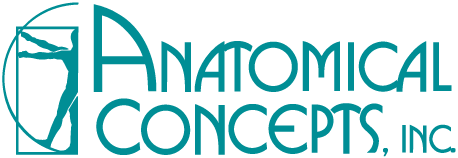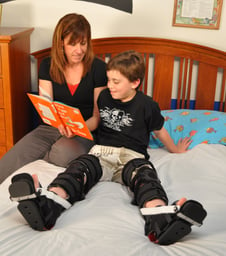![[ACI]-December-Blog-Graphic-v1](https://www.anatomicalconceptsinc.com/hs-fs/hubfs/%5BACI%5D-December-Blog-Graphic-v1.jpg?width=1200&name=%5BACI%5D-December-Blog-Graphic-v1.jpg)
Earlier in 2021, our blog titled "A Complete Guide to Pediatric Orthotic Bracing" provided answers to frequently asked questions about pediatric orthotics and discussed options available to treat children with conditions like Blount’s Disease, Rickets, and Bow Leg.
We also highlighted the features and benefits of our pediatric custom KAFO and the pediatric PRAFO, two products we recommend for treating children with these conditions.
In Part 2, we’ll take a closer look at how orthotic bracing, specifically ankle-foot orthotics, can be an effective treatment option for pediatric patients who have cerebral palsy.
Cerebral Palsy in Children
Cerebral palsy (CP) is a group of disorders that affect a child’s movement, ability to balance, and posture. CP is considered to be the most common motor disability in childhood. It is caused by abnormal brain development or damage to the brain, which affects the sufferer’s ability to control their muscles.
If you regularly treat children with CP, you know that symptoms vary from person to person. A child with severe CP might need special equipment to walk or not be able to walk at all and require lifelong care. Someone with mild CP may walk awkwardly but not need any assistance.
According to Cerebral Palsy Guidance, an organization that provides information, assistance, and support to parents of children with cerebral palsy...
- Cerebral palsy is the most diagnosed childhood motor disability in the United States.
- Approximately 10,000 babies are born annually with cerebral palsy, while between 1,200 and 1,500 school-aged children are diagnosed with cerebral palsy each year.
- The Autism and Developmental Disabilities Monitoring (ADDM) reports that 1 in 323 children have some form of cerebral palsy.
- More than 50 percent of all children with cerebral palsy can walk independently. In comparison, about 41 percent of babies and children with cerebral palsy will have limited crawling, walking, and running abilities.
While CP has no cure, there are treatment options doctors can incorporate into their patient’s treatment plan to improve their quality of life and help them manage symptoms.
Common treatments include medicine, surgery, physical, occupational, speech therapy, and orthotics. We’ve worked with physicians who introduce all or a combination of these treatments to children suffering from CP.
How Pediatric Orthotics Help Children with CP
Children with cerebral palsy struggle with motor control, posture, and balance, which means their bodies must exert more energy to perform even the most basic movements.
Orthotics can help them with mobility by stabilizing and supporting correct musculoskeletal alignment to develop better form and minimize strain on the body.
Orthotics serve as an essential treatment tool to help children increase mobility, limit pain, and enjoy an improved quality of life.
Here are several benefits orthotics, including ankle-foot devices, can provide.
They Manage Spasticity
One of the most prevailing secondary effects of cerebral palsy is spasticity. Spasticity refers to a high muscle tone caused by involuntary muscle contractions. It places excess pressure on the muscles and joints, causing stiff movements, sudden jerking, joint dislocation, and pain.
Wearing the correct orthotic device on the affected body area can significantly reduce the impact of spasticity. Orthotics hold the body part in place to prevent unwanted movements and minimize spastic muscles from tightening too much.
Orthotics also gently stretch tight muscles, even when the child is not moving. That allows for the lengthening of spastic muscles, limiting the progression of spasticity.
They Correct Posture
Children with cerebral palsy sometimes experience high or low muscle tone or a little of both. If they have low muscle tone in their abdominal muscles, they may have poor trunk stability and balance skills. That causes posture issues.
A therapist or physician may recommend that the child wear a trunk brace to prevent these complications. The device provides stability and structural support necessary to help individuals sit upright.
They Decrease Pain
Spasticity strains the musculoskeletal system, which may cause the child to develop chronic pain. The consistent musculoskeletal pain disrupts sleep, affects mood, and hinders growth in children with cerebral palsy.
Orthotics can assist with correcting musculoskeletal alignment to relieve the pain and discomfort caused by excess pressure on the muscles, bones, and joints.
They Minimize Deformity
Cerebral palsy-related motor impairments often present themselves in early childhood. That means they can significantly affect the growth and development of children with the condition.
High muscle tone can pull the body into abnormal positions as children grow. Deformities may develop when the muscles remain contracted or tightened for long periods during growth. Orthotics can help correct these abnormal positions.
They Can Be Custom-Made
Not all orthotics are custom-made. But devices prescribed by a physician usually are. Every one of your patients is different, so we help doctors ensure that each orthotic they choose for their patient is just the right fit. That way, the device provides the maximum amount of support and effectiveness.
They Are Low Risk .jpg?width=216&name=Lifestyle-%20Ped%20KAFO%20(post%201).jpg)
Orthotics are one of the safest and most effective treatment options for children with cerebral palsy. They can be temporary, and because they are wearable solutions, they can be taken off or adjusted if they are causing distress or discomfort for the child.
Devices are a non-invasive, affordable treatment option that can help doctors avoid putting children through a surgical procedure.
ACI works with physicians and therapists to help treat children who have cerebral palsy. Our AFO orthoses come in pediatric sizes to meet the needs of children and young adults experiencing motor impairment due to lower extremity conditions. Some products are also available in infant sizes.
Our experts manufacture each product to correct abnormalities and enhance patient mobility.
To learn more about how we can help your patients, visit our pediatric orthotics product page here.
 330-757-3569
330-757-3569




.png?width=252&name=Cerebral%20Palsy%20(1).png)


